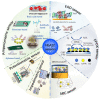A Review of Electrochemical Sensors for the Detection of Glycated Hemoglobin
- PMID: 35448281
- PMCID: PMC9024622
- DOI: 10.3390/bios12040221
A Review of Electrochemical Sensors for the Detection of Glycated Hemoglobin
Abstract
Glycated hemoglobin (HbA1c) is the gold standard for measuring glucose levels in the diagnosis of diabetes due to the excellent stability and reliability of this biomarker. HbA1c is a stable glycated protein formed by the reaction of glucose with hemoglobin (Hb) in red blood cells, which reflects average glucose levels over a period of two to three months without suffering from the disturbance of the outside environment. A number of simple, high-efficiency, and sensitive electrochemical sensors have been developed for the detection of HbA1c. This review aims to highlight current methods and trends in electrochemistry for HbA1c monitoring. The target analytes of electrochemical HbA1c sensors are usually HbA1c or fructosyl valine/fructosyl valine histidine (FV/FVH, the hydrolyzed product of HbA1c). When HbA1c is the target analyte, a sensor works to selectively bind to specific HbA1c regions and then determines the concentration of HbA1c through the quantitative transformation of weak electrical signals such as current, potential, and impedance. When FV/FVH is the target analyte, a sensor is used to indirectly determine HbA1c by detecting FV/FVH when it is hydrolyzed by fructosyl amino acid oxidase (FAO), fructosyl peptide oxidase (FPOX), or a molecularly imprinted catalyst (MIC). Then, a current proportional to the concentration of HbA1c can be produced. In this paper, we review a variety of representative electrochemical HbA1c sensors developed in recent years and elaborate on their operational principles, performance, and promising future clinical applications.
Keywords: HbA1c sensor; cyclic voltammetry; diabetes; electrochemical impedance spectroscopy; electrochemical sensor; fructosyl valine sensor.
Conflict of interest statement
The authors declare no conflict of interest.
Figures






Similar articles
-
Recent Progress in Electrochemical HbA1c Sensors: A Review.Materials (Basel). 2015 Mar 17;8(3):1187-1203. doi: 10.3390/ma8031187. Materials (Basel). 2015. PMID: 28787996 Free PMC article. Review.
-
An amperometric biosensor for specific detection of glycated hemoglobin based on recombinant engineered fructosyl peptide oxidase.Int J Biol Macromol. 2020 Jan 1;142:855-865. doi: 10.1016/j.ijbiomac.2019.10.025. Epub 2019 Oct 14. Int J Biol Macromol. 2020. PMID: 31622711
-
Glycated hemoglobin detection with electrochemical sensing amplified by gold nanoparticles embedded N-doped graphene nanosheet.Biosens Bioelectron. 2017 Mar 15;89(Pt 1):578-584. doi: 10.1016/j.bios.2016.02.033. Epub 2016 Feb 12. Biosens Bioelectron. 2017. PMID: 26897102
-
Affinity sensor for haemoglobin A1c based on single-walled carbon nanotube field-effect transistor and fructosyl amino acid binding protein.Biosens Bioelectron. 2019 Mar 15;129:254-259. doi: 10.1016/j.bios.2018.09.069. Epub 2018 Sep 20. Biosens Bioelectron. 2019. PMID: 30297174
-
A comprehensive review on fructosyl peptide oxidase as an important enzyme for present hemoglobin A1c assays.Biotechnol Appl Biochem. 2025 Feb;72(1):268-281. doi: 10.1002/bab.2647. Epub 2024 Aug 4. Biotechnol Appl Biochem. 2025. PMID: 39099239 Review.
Cited by
-
Advances in Nanomaterial-based Biosensors for Determination of Glycated Hemoglobin.Curr Top Med Chem. 2022;22(27):2261-2281. doi: 10.2174/1568026622666220915114646. Curr Top Med Chem. 2022. PMID: 36111762
-
Recent Advances in Electrochemical Aptasensors for Detection of Biomarkers.Pharmaceuticals (Basel). 2022 Aug 12;15(8):995. doi: 10.3390/ph15080995. Pharmaceuticals (Basel). 2022. PMID: 36015143 Free PMC article. Review.
-
Investigating the Electric Field Lysis of Exosomes Immobilized on the Screen-Printed Electrode and Electrochemical Sensing of the Lysed-Exosome-Derived Protein.Biosensors (Basel). 2023 Feb 27;13(3):323. doi: 10.3390/bios13030323. Biosensors (Basel). 2023. PMID: 36979537 Free PMC article.
-
Developing a Portable Autofluorescence Detection System and Its Application in Biological Samples.Sensors (Basel). 2024 May 23;24(11):3351. doi: 10.3390/s24113351. Sensors (Basel). 2024. PMID: 38894145 Free PMC article.
-
Effect of glycotoxicity and lipotoxicity on carbohydrate antigen 19 - 9 in the patients with diabetes.BMC Endocr Disord. 2024 Apr 24;24(1):51. doi: 10.1186/s12902-024-01578-5. BMC Endocr Disord. 2024. PMID: 38654232 Free PMC article.
References
-
- Subramaniam M., Abdin E., Vaingankar J.A., Chang S., Sambasivam R., Jeyagurunathan A., Seow L.S.E., Van Dam R., Chow W.L., Chong S.A. Association of adverse childhood experiences with diabetes in adulthood: Results of a cross-sectional epidemiological survey in Singapore. BMJ Open. 2021;11:e045167. doi: 10.1136/bmjopen-2020-045167. - DOI - PMC - PubMed
-
- Deshmukh C.D., Jain A. Diabetes Mellitus: A Review. Int. J. Pure Appl. Biosci. 2015;3:224–230.
-
- Yadav J., Rani A., Singh V., Murari B.M. Prospects and limitations of non-invasive blood glucose monitoring using near-infrared spectroscopy. Biomed. Signal Process. Control. 2015;18:214–227. doi: 10.1016/j.bspc.2015.01.005. - DOI
Publication types
MeSH terms
Substances
Grants and funding
- No.61873307/National Natural Science Foundation of China
- No.61503322/National Natural Science Foundation of China
- No.F2021203070/Natural Science Foundation of Hebei Province of China
- No. ZD2019305/Scientific Research Project of Colleges and Universities in Hebei Province
- N2023015/Fundamental Research Funds for the Central Universities
LinkOut - more resources
Full Text Sources

